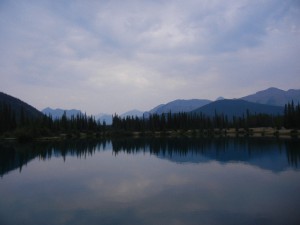9-10 August: We said good-bye to Rob & Judith, who were headed north to Wood Buffalo National Park, along the border between Alberta and Northwest Territories, while we headed south for a couple of more days with Dick & Sonia before our paths also diverged. Our next campground, in McLean Provincial Park, was in the area known as Kananaskis Country, in the foothills on the eastern side of the Rockies, between Banff and Montana. Although conveniently close to Calgary, this campground would normally have been full of noise, dust, and fumes, because it is a major campground and trailhead for off-highway vehicles. Fortunately for us, there was a ban in effect for the use of recreational OHVs, due to the danger of sparking additional wildfires. We enjoyed the quiet by going for a couple of short walks nearby. The Elbow River flows eastward down from the mountains, and is large enough to provide water to about a third of the entire population of the province of Alberta. Although Elbow Falls didn’t look very big when we were there, the flow rate varies 100-fold during the year, and the very wide river bed and huge amount of large rounded cobbles indicated how great the spring floods must be. Forgetmenot Lake was originally a large gravel pit that filled with spring water and now has a decent sized outlet stream despite having negligible flow from inlet streams.


The next day we drove into Calgary and devoted our attention to the Glenbow, a museum of art, cultural history, and natural history. We went on a tour and talk about the special exhibit by Ken Monkman, a Canadian artist of Cree heritage. His paintings were large, modern, and even shocking, symbolizing the plight of native people resulting from being colonized, Christianized, urbanized, and modernized. Many of his works were closely based on well-known classical paintings, with a strong satirical twist. We had a tasty lunch at a place on Stephen Street, a pedestrian way with lots of restaurants near the Glenbow, then went back in for the rest of the afternoon and focused on exhibits on Northwestern art (the Northwest Territories once included all of what is now western Canada), the romance of canoes (birch bark as well as cedar), the culture of the Blackfeet in particular and First Nations tribes in general.

